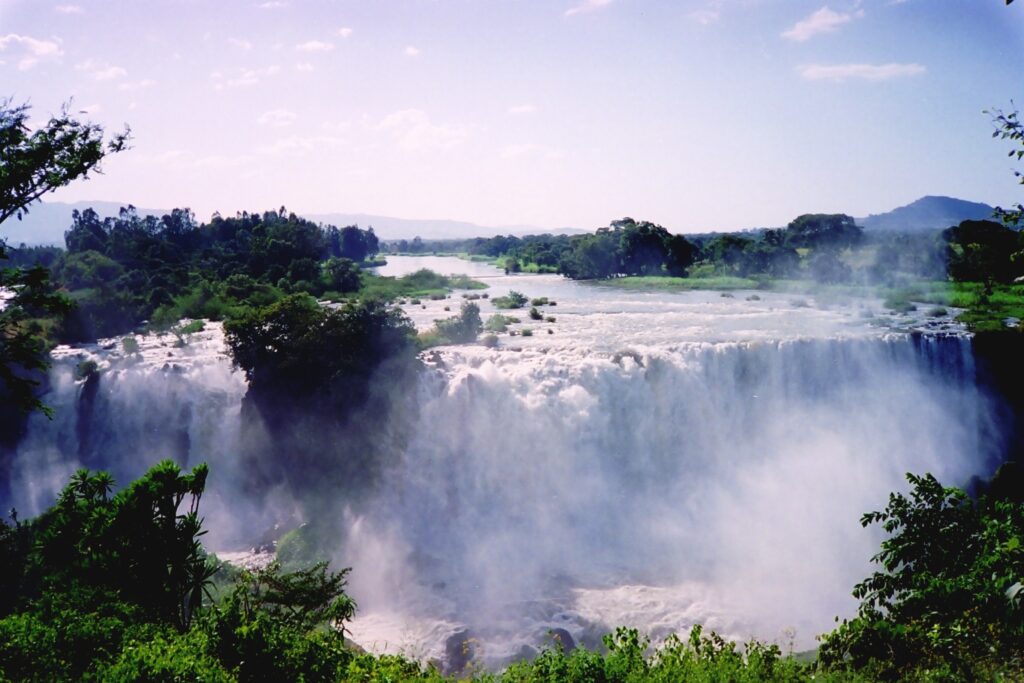Nestled in the heart of Ethiopia, Bahir Dar is a vibrant city that serves as the gateway to the majestic Blue Nile. Known for its lush landscapes and rich history, Bahir Dar is a must-visit destination for those eager to explore the origins of one of the world’s most famous rivers. The source of the Blue Nile is a place of natural beauty and cultural significance, offering visitors a unique glimpse into the life and history of the region.
What to See
The Blue Nile River begins its journey from Lake Tana, Ethiopia’s largest lake, located just a short distance from Bahir Dar. The lake itself is a sight to behold, dotted with 37 islands, many of which are home to ancient monasteries. These monasteries, some dating back to the 14th century, are rich in religious art and history, offering a serene and spiritual experience for visitors.
One of the most popular attractions is the Blue Nile Falls, locally known as Tis Abay, meaning “Great Smoke.” The falls are about 30 kilometers downstream from Bahir Dar and are a breathtaking spectacle, especially during the rainy season when the water flow is at its peak. The surrounding area is perfect for hiking and offers stunning views of the falls and the lush greenery.
A Bit of History and Interesting Facts
The Blue Nile has been a source of fascination for centuries, playing a crucial role in the history and culture of Ethiopia. It is one of the two major tributaries of the Nile River, the other being the White Nile. The Blue Nile contributes about 80% of the water and silt that reaches Egypt, making it a vital water source for the countries along its path.
Historically, the Blue Nile was a mystery to many explorers who sought its source. It wasn’t until the 17th century that the source was identified as Lake Tana. The river has been central to Ethiopian culture and history, often associated with legends and religious significance.
An interesting fact about the Blue Nile is its role in the annual flooding of the Nile River in Egypt, which was crucial for agriculture in ancient times. The river’s journey from Ethiopia to the Mediterranean Sea spans over 1,450 kilometers, making it a vital waterway for the region.
How to Get There and Tips for First-Time Visitors
Bahir Dar is accessible by air, with regular flights from Addis Ababa, the capital of Ethiopia. The flight takes about an hour, making it a convenient option for travelers. Alternatively, you can take a bus or drive from Addis Ababa, which takes approximately 8 to 10 hours, offering a scenic view of the Ethiopian countryside.
Once in Bahir Dar, getting to the source of the Blue Nile is relatively easy. You can hire a local guide or join a tour to explore Lake Tana and the Blue Nile Falls. It’s advisable to visit during the dry season (October to March) for easier access to the falls and monasteries, although the falls are more impressive during the rainy season (June to September).
For first-time visitors, it’s important to respect local customs and dress modestly, especially when visiting religious sites. Hiring a local guide can enhance your experience, providing insights into the history and culture of the area. Don’t forget to try the local cuisine, which includes delicious dishes like injera and doro wat.
The source of the Blue Nile in Bahir Dar is not just a geographical landmark but a place of immense beauty and historical significance. Whether you’re a history buff, nature lover, or simply seeking a unique travel experience, Bahir Dar offers a captivating journey into the heart of Ethiopia.








